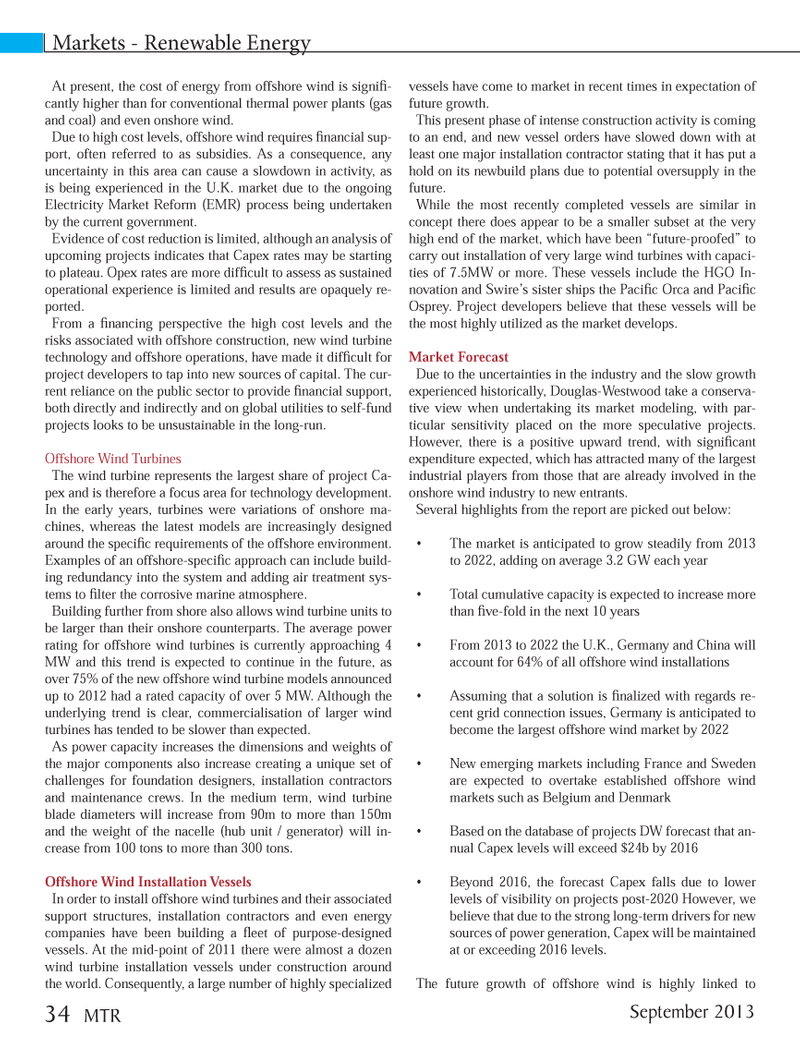
Page 34: of Marine Technology Magazine (September 2013)
Ocean Observation: Gliders, Buoys & Sub-Surface monitoring Networks
Read this page in Pdf, Flash or Html5 edition of September 2013 Marine Technology Magazine
At present, the cost of energy from offshore wind is signiÞ -cantly higher than for conventional thermal power plants (gas and coal) and even onshore wind. Due to high cost levels, offshore wind requires Þ nancial sup- port, often referred to as subsidies. As a consequence, any uncertainty in this area can cause a slowdown in activity, as is being experienced in the U.K. market due to the ongoing Electricity Market Reform (EMR) process being undertaken by the current government. Evidence of cost reduction is limited, although an analysis of upcoming projects indicates that Capex rates may be starting to plateau. Opex rates are more difÞ cult to assess as sustained operational experience is limited and results are opaquely re- ported. From a Þ nancing perspective the high cost levels and the risks associated with offshore construction, new wind turbine technology and offshore operations, have made it difÞ cult for project developers to tap into new sources of capital. The cur- rent reliance on the public sector to provide Þ nancial support, both directly and indirectly and on global utilities to self-fund projects looks to be unsustainable in the long-run.Offshore Wind Turbines The wind turbine represents the largest share of project Ca- pex and is therefore a focus area for technology development. In the early years, turbines were variations of onshore ma- chines, whereas the latest models are increasingly designed around the speciÞ c requirements of the offshore environment. Examples of an offshore-speciÞ c approach can include build- ing redundancy into the system and adding air treatment sys- tems to Þ lter the corrosive marine atmosphere. Building further from shore also allows wind turbine units to be larger than their onshore counterparts. The average power rating for offshore wind turbines is currently approaching 4 MW and this trend is expected to continue in the future, as over 75% of the new offshore wind turbine models announced up to 2012 had a rated capacity of over 5 MW. Although the underlying trend is clear, commercialisation of larger wind turbines has tended to be slower than expected. As power capacity increases the dimensions and weights of the major components also increase creating a unique set of challenges for foundation designers, installation contractors and maintenance crews. In the medium term, wind turbine blade diameters will increase from 90m to more than 150m and the weight of the nacelle (hub unit / generator) will in-crease from 100 tons to more than 300 tons.Offshore Wind Installation Vessels In order to install offshore wind turbines and their associated support structures, installation contractors and even energy companies have been building a ß eet of purpose-designed vessels. At the mid-point of 2011 there were almost a dozen wind turbine installation vessels under construction around the world. Consequently, a large number of highly specialized vessels have come to market in recent times in expectation of future growth. This present phase of intense construction activity is coming to an end, and new vessel orders have slowed down with at least one major installation contractor stating that it has put a hold on its newbuild plans due to potential oversupply in the future.While the most recently completed vessels are similar in concept there does appear to be a smaller subset at the very high end of the market, which have been Òfuture-proofedÓ to carry out installation of very large wind turbines with capaci- ties of 7.5MW or more. These vessels include the HGO In- novation and SwireÕs sister ships the PaciÞ c Orca and PaciÞ c Osprey. Project developers believe that these vessels will be the most highly utilized as the market develops. Market Forecast Due to the uncertainties in the industry and the slow growth experienced historically, Douglas-Westwood take a conserva- tive view when undertaking its market modeling, with par- ticular sensitivity placed on the more speculative projects. However, there is a positive upward trend, with signiÞ cant expenditure expected, which has attracted many of the largest industrial players from those that are already involved in the onshore wind industry to new entrants. Several highlights from the report are picked out below: ¥ The market is anticipated to grow steadily from 2013 to 2022, adding on average 3.2 GW each year ¥ Total cumulative capacity is expected to increase more than Þ ve-fold in the next 10 years ¥ From 2013 to 2022 the U.K., Germany and China will account for 64% of all offshore wind installations ¥ Assuming that a solution is Þ nalized with regards re- cent grid connection issues, Germany is anticipated to become the largest offshore wind market by 2022 ¥ New emerging markets including France and Sweden are expected to overtake established offshore wind markets such as Belgium and Denmark ¥ Based on the database of projects DW forecast that an- nual Capex levels will exceed $24b by 2016 ¥ Beyond 2016, the forecast Capex falls due to lower levels of visibility on projects post-2020 However, we believe that due to the strong long-term drivers for new sources of power generation, Capex will be maintained at or exceeding 2016 levels. The future growth of offshore wind is highly linked to Markets - Renewable Energy September 201334 MTRMTR #7 (34-49).indd 34MTR #7 (34-49).indd 348/22/2013 10:57:00 AM8/22/2013 10:57:00 AM

 33
33

 35
35
